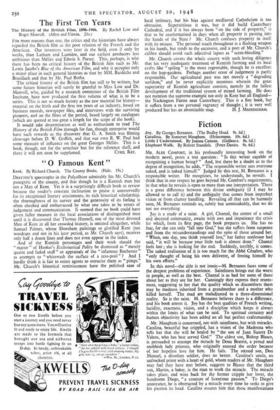"0 Famous Kent"
Kent. By Richard Church. The County Books. (Hale. 15s.)
DRAYTON'S apostrophe in the Polyolltion admirably fits Mr. Church's panegyric of the county, and that though he is a Kentish man but not a Man of Kent. Yet it is a surprisingly difficult book to review because the reader's constant inclination to praise it unreservedly for its exceptional literary attainments, its rich historical scholarship, the thoroughness of its survey and the generosity of its feeling is often checked and embarrassed by what one takes to be errors of judgement and communication. It seemed that no book could have given fuller measure in the local associations of distinguished men until it is discovered that Thomas Hennell, one of the most devoted Men of Kent in all her crowded history, is omitted altogether, while Samuel Palmer, whose Shoreham paintings so glorified Kent (not woodcuts and not in his later period, as Mr. Church says), receives only half a dozen lines and does not even appear in the index.
And of the Kentish personages and their work should the " matter " of Hooker's Ecclesiastical Polity be dismissed as "merely quaint and faded stuff" or appraisals of the "infamous Rochester" as attempts to "whitewash the surface of a cess-pool " ? And I hardly think it is fair to estate agents to ostracise them as "pimps." Mr. Church's historical reminiscences have the polished ease of local intimacy, but his bias against mediaeval Catholicism is too obtrusive. Superstitious it was, but it did build Canterbury Cathedral, and if it has always been "on the side of property," is that to be anathematised in days when all property is passing into the hands of the State ? Mr. Church confuses property in itself with its misuse. The personal touch throughout is a flashing weapon in his hands, but tends to the excessive, and a poet of Mr. Church's calibre should avoid such adjectival lapses as "scent-bleeding."
Mr. Church covers the whole county with such loving diligence that his very inadequate treatment of Kentish farming and its local crafts like " spiting " is the more regrettable, though he is excellent on the hop-gardens. Perhaps another error of judgement is partly responsible. Our agricultural past was not merely a "degrading serfdom," and he never explicitly mentions wherein the great superiority of Kentish agriculture consists, namely in the fullest development of the traditional system of mixed farming. He does not mention the supreme example not only in Kent but all England— the Nackington Farms near Canterbury. This is a fine book, but it suffers from a too personal vagrancy of thought ; it is very well
produced but has an abominable map. H. J. MASSINGHAM.


































 Previous page
Previous page